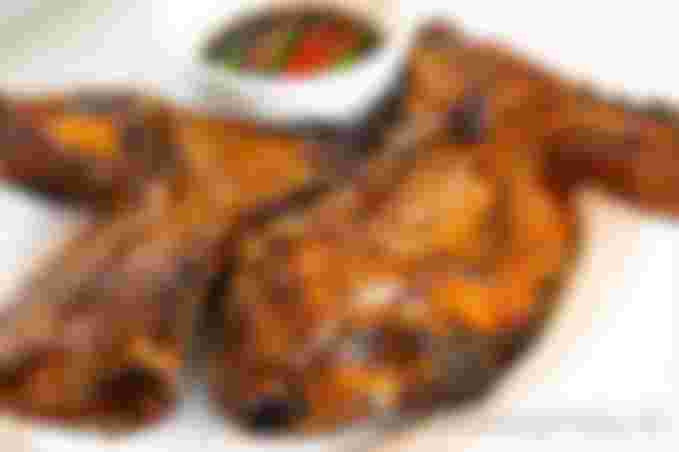As I promised, I'm going to write and introduce more about Filipino cuisine; this time, I'm going to present to you a popular fish meat, the tuna. And it's a popular catch in my hometown— General Santos City.
In the Philippines, if you'll say tuna, there's no place that you could associate to such magnificent and remarkable fish but General Santos City, my hometown. General Santos City or locally known as Gensan, once called Dadiangas in its earlier foundation, is located in the province of South Cotabato in Mindanao, and it's the heart of economic hub in the south where many malls, trade centers, universities, airport and fishport are located.
Though my hometown city is not known for many historical landmarks that visitors can explore, there are still certain things and places you can try and visit that are surely unique to General Santos alone. This is aside from the many resorts and beaches you can visit in General Santos City. Furthermore, getting to know the city first-hand would still be an adventure on its own.
Tuna Capital of the Philippines.

Photo source: https://www.mindanews.com/business/2012/12/pacific-tuna-ground-free-for-all-once-more/
The name Tuna Capital of the Philippines was already dubbed to the city as early as 1970, as it's leading in amount of the total daily catch of fish compared to other fishing port in the country. The SOCSKSARGEN(South Cotabato, Sultan Kudarat, Sarangani, and Gensan) tuna industry – 90% of which is based in General Santos City – lands around 350 metric tons of tuna (yellowfin, skipjack and big eyes) per day. 30% is exported to US, Europe and Japan, 30 % goes to the local market and 40% is processed. The Philippines is ranked second largest canned and process tuna manufacturer in Asia, seven tuna canneries in the country are based in General Santos City. Hence, the name tuna capital of the Philippines.
The Gensan Fisport Complex is located in Brgy. Tambler, General Santos City with an area of 32 hectares that lies along the shores of Sarangani Bay. Constructed and financed by Japanese Overseas Economic Cooperation Fund under the Nationwide Fishing Ports Project Package II, the port complex is the second largest fish port in the Philippines next to Navotas Fish Port Complex.
The LGU(Local Government Unit) also boasted its HACCP( Hazard Analysis and Critical Control Point) accredited processing plants. HACCP is a system developed by the World Health Organization which is designed to ensure the safety of food products processed by establishments not just in the country, but also around the world. Therefore, the tuna catches here are truly fresh and safe to consume.
Su—Tu—Kil.
That's sound bad, right? Actually, it is not that bad, and I'm not talking about shooting someone to death—though it's sound like shoot-to-kill— but I'm referring to the most popular dishes made from tuna in my hometown. Su—Tu—Kil stands for Sugba(grilled tuna jaw, belly, or tail), Tuwa/tinola( tuna fish broth), and Kilaw/kinilaw( raw tuna meat dressed with vinegar).
Warning: Salivating Pictures and Descriptions ahead.
Sugba/sinugba is a grilled part of either tuna's, particularly yellow-finned tuna, fleshy jaw, tuna belly or buntot(tuna tail). The fleshy jaw were contain lots of collagen infused meat making it super juicy, tasty and tender when cooked. This part in developed countries are mostly thrown away but in Asian countries, especially here in the Philippines, this is the most sought after part hence you won’t see this sold in major supermarkets and only in Asian shops. In Gensan, the tuna jaws were marinated with soy sauce and spices before grilling it in the charcoal. Same with the tuna bellies, a fatty part of the fish. I could say that this is the tastiest part of tuna especially if it's marinated with soy sauce and other kinds of sauces like oyster sauce plus spices. Tuna buntot or tail is also a fatty part of the fish and is also marinated and grilled in charcoal. Those were best served as a pulutan or Pinoy beer matches.

Photo source: https://panlasangpinoy.com/inihaw-na-panga-ng-tuna-grilled-tuna-jaw/

Photo source: https://www.maggi.ph/recipes/grilled-tuna-belly/
Tuwa/tinola is a dish of fish cooked in a clear broth. The broth is composed of ginger, lemon grass, onions or leeks, tomatoes, malungay(moringa), chillies, and of course, the star of the dish, the tuna meat. It is a light and clear stew dish which best serves when it's hot and the weather is cold. For me, the fish's head, belly and the buntot (tail) are the best part for tinola.

Photo source: http://nusarecipe.blogspot.com/2013/09/tinolang-tuna.html?m=1
Kilaw/kinilaw is a dish of cubed raw meat of tuna(sashimi meat) in vinegar-based dressing. It is also called as Philippines ceviche because of it's similarity on the Latin-American dish ceviche. It is also mixed with calamansi juice chop onions, ginger, and chillies and served as an appetizer or finger food. Sometimes, it's a best partner for an alcoholic beverage.

Photo source: https://panlasangpinoy.com/easy-tuna-kilawin-recipe/
Nothing is wasted.
All parts of tuna are actually has a high-value and are maximize for profit. Even the bagabay(gonads), bihod(caviar), laman luob(mixed intestines) are being sold in the local market. Mixed intestines of tuna are fermented to make dayok, one of my favorite condiment. It has a similar taste of patis(salted fish sauce).

Photo source: https://www.google.com/amp/s/nikdottravel.wordpress.com/2018/11/23/why-travel-solo-for-the-nth-time/amp/
General Santos City may not be as developed as the big cities like Manila, Cebu, and Davao, and is visited for it's tourist spots, nevertheless, it is a city that you must visit for its food and meet hard-working people.
Thank you for reading.
Lead photo source: https://lovepilipinas.com/event/general-santos-tuna-festival/





